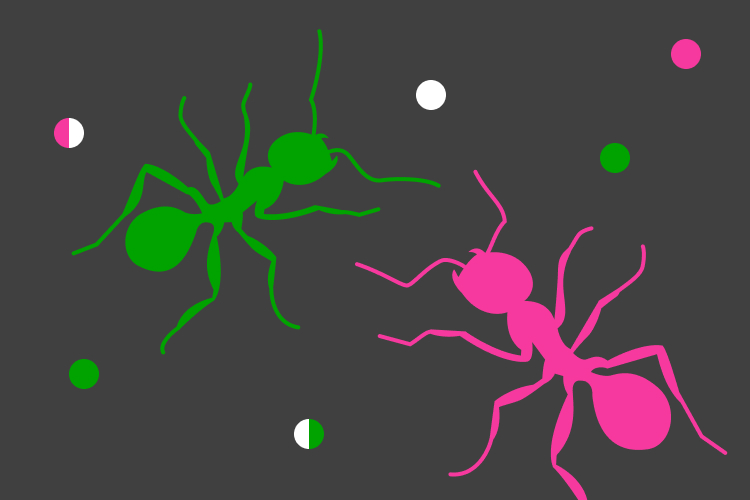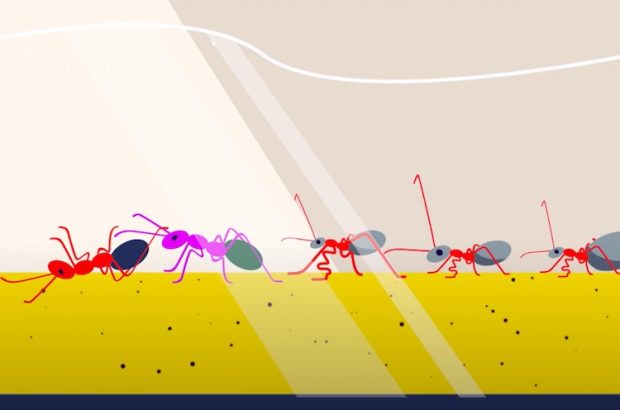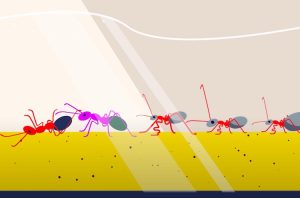Fire ants conquer the world on the first global tr...
New study describes genealogy and spreading of one of the most damaging species of pest ants

If you look at Ants as societies, there are two ways that they can engage in what we call “Wars”. One of them is more similar to the way that humans think of having wars – battles among the colonies of the same species. The other type involves interactions between different species of ants. Both of these kinds of conflicts are important to ant biology.
Ant Wars are a direct, aggressive interaction between ants of different colonies. Ants are engaged in competition with other ants. For example, if one colony monopolizes the supply of food, this source is unavailable to other ants – that is an indirect form of competition. Ant Wars in the context of competition would be the conflict when ants physically engage in direct battles with each other. In fact, one of the things that make ants interesting is that they have conflicts both within species and between species.
The Ant Wars were known and first recognized even before modern biologists became interested in this phenomenon. For example, even Charles Darwin wrote about conflicts between ants. There are references to the success of ant societies in the Bible because people were interested in and observing this phenomenon for thousands of years. In part, ant wars draw attention because battles between ant colonies can be very striking, very obvious, and very dramatic, but also because ants are social species like humans, and there is a lot of temptation to compare and draw parallels between the two societies. It is interesting to see this history of comparisons as cross-talk: there is interest in how ant warfare can confirm existing ideas or tell us something new about human conflict, and there is also an interest in taking theory that was developed for human conflict and asking whether this can help us to understand ant conflicts.
Ants are social insects, and the usual situation in insect societies is that a colony is a cohesive unit and it has some level of genetic integrity. In other words, there is a familial structure that holds the colony together, although that structure can be somewhat complicated. The colony develops the ability to distinguish and recognize all its colony members. Ants tend to separate the world in a rather simple way into two classes: colony members and everybody else. There is a very strong in-group identity that develops and unites the colony, at least for most species and under most circumstances.
Ants are, therefore, likely to run into members of other colonies or even of other species. In a habitat that contains a lot of ant species, the odds of colonies bumping into each other, cross-species, are very high. These kinds of interactions are very frequent. If a colony perceives that there is a threat of losing resources of losing territory from either another species of ants or another colony of the same species, then that threat develops an organized aggressive response, which might sometimes lead to an actual battle.
Ants are ancient insects; they have been present since long before the breakup of the supercontinent of Gondwana. That goes back more than 100 million years, and ants have been around for quite some time before it happened. Of course, Ants were engaging in Wars for many tens of millions of years, if not even on the order of the hundreds of millions of years.
Ants have a range of weapons that they can use in Ant Wars. That suggests these aggressive conflicts have been very important to their evolution. Scientists that study ants’ evolution talk about the shift in object of ant aggression that happened as they evolved. Long ago, early evolved lineages of ants had vertebrates (large land animals like dinosaurs, birds, and mammals) as their major enemies. A lot of these ants were equipped with a very powerful sting – these ants are very good at attacking enemies like humans, but their stings are usually not that effective on other insects.
As ants evolved and became more ecologically abundant, their pressure on each other became more important. This led to the role of Ants’ greatest enemy shifting from vertebrates to other ants. It seems kind of counterintuitive, but some lineages of ants actually lost their sting. In many of these lineages, the sting became modified into a chemical weapons delivery system that is good at being used against other ants. It is as if the ants have given up their capacity to fight vertebrate enemies like us, in favor of the ability to attack and fight off and win battles against other ants.
Now, in fact, a lot of ants have a specialized kind of weaponry that is not very effective on mammals but works really well against other ants. The sources and the details of these chemicals- where exactly in the body they are being produced, what chemicals are used- vary among ant species. Across different types of ants you could find glands that are used in Ant Wars on just about every part of the body. The chemical products are also extremely diverse. There have been independent evolutionary origins of this weaponry that have evolved in different lineages of ants, which have come up with different solutions to this common problem.
Ants have all kinds of different weapons. Biting is usually involved. Oftentimes ants will cooperate – members of an aggressive colony will do things like pin down members of the other colonies or cut them to pieces while the enemy is being held down. Ants are really quite nasty. There are at least one species where the workers have a very large gland in their bodies, and when they get upset enough, they can exert pressure on it and literally explode, spewing a glue-like substance on the surrounding area. Other ants have various kinds of glands, sometimes in the head and sometimes in the abdomen, that exude toxic chemicals that confuse their enemies. Thus their conflict ranges from physical fighting to chemical warfare, just like it does in humans.
There is an interesting phenomenon that has almost certainly been affected by human habitat change. What we are seeing now has happened repeatedly around the world – intrusions by invasive ants. When an invader insect gets introduced into a new habitat by humans, it can spread massively, and it can achieve densities that are completely unprecedented in its native habitat. The ranges of invasive ants can cover absolutely monstrous areas – thousands of square kilometers.

Why are these invasions successful? A feature of the biology of these species that are associated with their success is unicoloniality. The idea of unicoloniality is that these species have, for some reason, lost or given up their ability to recognize colony boundaries. A normal situation would be when a colony has a chemical signature so that the ants could tell their colony mates from non-colony ants; in a lot of invasive ant species, that capacity has been lost. Within a species, they basically greet all the other ants that they contact as members of their own colony.
One possibility is that giving up Ant Wars, battles within the species, and developing a willingness to embrace members of other colonies into your own nest has reduced the amount of cost that these ants incur. That has allowed them to increase their population sizes, be successful, and become superior competitors. What they still do is treat other species as enemies or as foreigners, but they are not aggressive within their own species. The result is effectively a single colony of ants spreading across thousands of kilometers or thousands of miles of distance. The ants from one end of the range could be introduced to the other end of the range, and they would not interact aggressively. This is repeatedly happening and is quite astonishing. These ants that have become successful invaders are not closely related to each other, they come from different subfamilies of ants, and they are very diverse.
This suggests that cooperation is a pathway to success. Of course, it is a matter of the level at which the cooperation is being expressed. We can again refer to the comparison between ants and human societies. People are social animals, and we do cooperate; we do form alliances. Ant colonies have a level of cooperation and integration that is almost impossible to achieve for humans. But a way in which humans are almost always different from ants is that we maintain, even within the context of a kin group or social unit, a lot of individual identities.
We, humans, get very excited about self-sacrificing behavior and generosity, and, in the end, what people do is a delicate dance between selfishness and cooperation. Ants differ from us in this sense. Within the colony group, selfishness and individual incentives, to a large extent, have been lost or disappeared. Ants still engage in fights across colony groups, but it is compelling and interesting that the invasive species that have given up those colony barriers appear to have increased ecological success.
Soldiers are a special type of ants within colonies of some species of ants. Soldiers are a part of the workforce that specializes in defense. Not all ant species have soldiers. Most ants only have one worker type. For the species that do produce specialized soldiers with large bodies, those soldiers differ in behavior from the rest of the workers. If the colony is attacked, the soldiers are the ones that will come to the forefront and defend the colony.
Army ants (AA) are an ant subfamily that has several unique behaviors. What’s special about AA is that they have taken sociality further and developed it better than probably any other kind of social animal we know, certainly better than any other type of social insect. One of the features of AA that makes them so interesting is that they do everything socially. All of their activities are performed by a closely interacting massive group of individuals. There is no individual independent activity, and individual workers never go off on their own.
The only members of AA colonies that go off alone are the males. Males are produced occasionally by the colony, they have wings, and they leave the colony to seek out young females from other colonies to mate with. All the other activities in the AA colonies are done in the company of groupmates or nestmates. There are no scouts, no individual foraging. Everything is done in a swarm of mass action. You can think of an AA colony as an unbroken unit, almost like an organism, like a pseudopod of the amoeba. It is as if an AA feeding raid is an arm or a leg that never breaks contact with the body. And everything they do is highly interactive and highly coordinated.
AA give great examples for thinking about and studying Ant Wars. They are also a bit different from most other kinds of ants. AA appear to divide the world into three categories: other colonies of the same species, other AA species, and other animals (including other kinds of ants). And they have completely different reactions to those three categories. Basically, AA do not engage in Ant Wars with other AA. However, some of AA’s favorite prey is other ant species.

Within the AA family of species, there are two different types of reaction: ignore or avoid. Imagine AA foraging – they send out a huge raid party, a carpet of AA workers that sweeps through the forest. Sometimes a swarm raid like this approaches the swarm raid of another different AA species. In this situation, one would expect to see a spectacular battle between two masses of AA. But most often, they just ignore each other: the two huge swarm parties pass through each other almost as if the other did not exist. It is quite amazing to see.
The other kind of interaction only happens very rarely. When two colonies of the same AA species meet and contact each other, they very quickly recognize that they have met up with members of another group. Instead of fighting, both colonies retreat in opposite directions, away from each other. They seem to go to great lengths to get as far away from each other as possible, which can include moving an entire colony even further away in the middle of the day. Thus, within species, AA show massive avoidance, and between species, they just ignore each other.
When AA encounter other ant species, on the other hand, they will almost invariably attack and try to kill each ant in that colony. AA invade and attack very large colonies of other species of ants as prey. Of course, the other ants fight back in many cases. Those battles can lead to huge losses of life on both sides. The war between an AA colony and a prey colony they are attacking is one of the most impressive, cataclysmic battles of any kind in nature. The AA typically end up prevailing, but they can suffer big losses in doing that.
AA have the ability to recruit massive numbers of nest mates when they discover a valuable resource. There is evidence that they have a special chemical to use, especially in that context- a recruitment pheromone. One area of new investigation about AA is their chemical tool kit. We know experimentally and functionally that they have different pheromones and different chemical signals that they use to send different messages, but we know almost nothing about the actual chemistry of those signals.
In terms of physical size, AAs are usually not exceptionally large. There are many other ants that have a much large body size than AA. But the way that AA achieves success is through the force of numbers. They have huge colony sizes, and everything they do is in massive, coordinated groups. If an AA colony encounters you, you are not just being found by one scout; you are essentially being found by a large part of the colony simultaneously. Automatically you’ve got a lot of individuals there to fight or confront and exploit whatever they find, and, unlike most ants, they don’t have to wait for recruitment to happen. They respond to everything in the environment as a social unit.
One species of AA in the new world tropics, with some regularity, invades mature colonies of leaf-cutter ants. AA and leaf-cutter ants in the new world tropics are two pinnacles of ant evolution in the sense that they have very large colonies, are highly socially sophisticated, and have lots of division of labor. When AA attack mature leaf-cutter ants colonies, soldiers of both species line up a face-off- leaf-cutter soldiers against AA soldiers – and engage in absolutely cataclysmic battles that can go on for days before the AA finally break through the defense and go down to the leaf-cutter nest and pillage the brood.
The leaf-cutter ants have giant nests, large colonies, and millions of workers in a single colony. They have huge mass chambers, with an enormous portion lying underground. They produce very large-body soldiers: a soldier can weigh hundreds of times what a small worker weighs. The soldiers really can’t do much work for the colony – they are massive, they are very expensive and their purpose has been a bit of a mystery to ant biologists.
If you look at how prey ants respond to AA raids, there is a wide range of responses. Some species fight back, and for others, the first few AA workers that show up lead to an immediate panic reaction, with the entire prey ant colony evacuating the nest. What they usually do is grab the babies and the offspring, run out, and carry themselves to a distance. There they stand and wait. After the AA depart, the prey ants can go back into the nest.
There’s a lot of interest in the biology of invasive ants. Researchers have begun to recognize that learning how the colonies do or don’t engage in conflict can help us understand biological invasions and the negative impacts that they could have. Some of these invasive ants are causing huge ecological problems, not only for humans but for the disrupted ecology of the places that they invade. Wiping out endangered species and changing habitat structure can have an absolutely monstrous effect on ecology.
They are also a problem for humans: they get in foodstuff, some of them sting, and they cause medical problems. In a way, it is almost like speaking about emerging diseases. Understanding ant wars can lead to clues to the characteristics of ant species that lead to them being invasive. It will, hopefully, help us respond to these invasions and may even predict when they are likely to happen again. So a lot of research on ant aggression and Ant Wars is being done to help understand biological invasions.
Another idea would be to look at the animal species exploiting the Ant Wars directly. A lot of ants have other species actually living inside of their colonies. These are referred to as myrmecophiles or ant lovers. These are animals that make their living by basically invading an ant colony. They are usually parasitic, but their effect is very small. Those animals evolve the ability to hide from the ants, almost as if they could be accepted into the ants’ colony. The colony recognition mechanism doesn’t work, but somehow they get around it. And those animals that are aligned with the ant colony, in the evolutionary sense, would be very interested in the outcome of Ant Wars. In other words, it’s bad for them if their colony is harmed. However, there is no evidence of those species participating directly in the battles, though it is an interesting guess.

We are focusing on two things in my lab right now. One is investigating brain evolution, trying to understand how the nervous system responds to different ecologies and whether the nervous system maps onto ants’ social roles and body sizes. The other line we are interested in is using AA to study temperature variation and possibly the effect of climate change on animal genetics and physiology. We think AA is a great model for doing this, partly because species of AA in the tropics can stand very wide elevation ranges: the same species are being exposed to very hot temperatures in the lowlands and very cold temperatures in the mountains.
From researching paper wasps in 2015, we’ve learned that there is a big shift in brain structure, in brain investment when you go from solitary species to social species. This potentially supports the notion that when you become social, your demands on individual brain power and cognition go down because you can share the information and integrate with other group members. It is almost like neural processing can be extracted at the group level. It was a very exciting discovery, and that kind of analysis needs to be replicated on other groups of social organisms to see if the same pattern holds. The reason this is important is that if we look at vertebrate societies, mammals, birds, and fish, most of them show the opposite pattern. In other words, if you increase sociality, brain investment also increases, while in insects, it might be exactly the opposite. This is a potentially very exciting area.
Also, there are a number of questions about the mega colonies we talked about previously that we could ask. How far does the integration within them really go? It’s probably quite local; the information can only be shared over a short distance. It is intriguing to think of the massively integrated colonies, though it’s unlikely there is information sharing over very long distances. However, it is an interesting possibility for a science fiction story.
Edited by Irina Laevskaya

New study describes genealogy and spreading of one of the most damaging species of pest ants

Geneticist Steve Jones on skin cancer, the effect of vitamin D and why the sunlight is good for health and dan...

Biologists have imaged ultra-small bacteria that are close to the lowest size limit possible for life on Earth